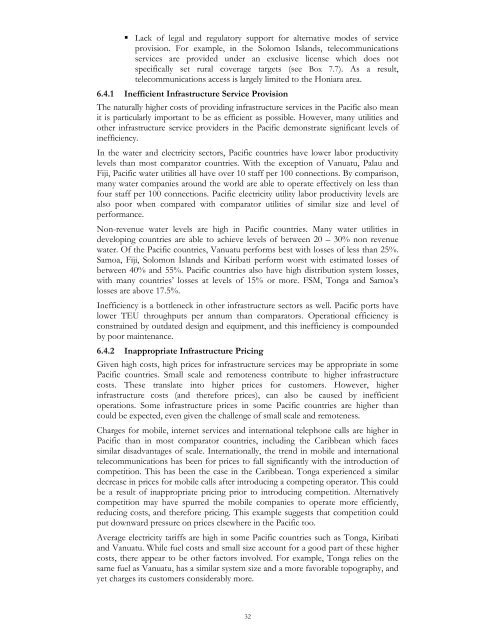EAP - The Pacific Infrastructure Challenge - World Bank (2006).pdf
EAP - The Pacific Infrastructure Challenge - World Bank (2006).pdf
EAP - The Pacific Infrastructure Challenge - World Bank (2006).pdf
You also want an ePaper? Increase the reach of your titles
YUMPU automatically turns print PDFs into web optimized ePapers that Google loves.
Lack of legal and regulatory support for alternative modes of service<br />
provision. For example, in the Solomon Islands, telecommunications<br />
services are provided under an exclusive license which does not<br />
specifically set rural coverage targets (see Box 7.7). As a result,<br />
telecommunications access is largely limited to the Honiara area.<br />
6.4.1 Inefficient <strong>Infrastructure</strong> Service Provision<br />
<strong>The</strong> naturally higher costs of providing infrastructure services in the <strong>Pacific</strong> also mean<br />
it is particularly important to be as efficient as possible. However, many utilities and<br />
other infrastructure service providers in the <strong>Pacific</strong> demonstrate significant levels of<br />
inefficiency.<br />
In the water and electricity sectors, <strong>Pacific</strong> countries have lower labor productivity<br />
levels than most comparator countries. With the exception of Vanuatu, Palau and<br />
Fiji, <strong>Pacific</strong> water utilities all have over 10 staff per 100 connections. By comparison,<br />
many water companies around the world are able to operate effectively on less than<br />
four staff per 100 connections. <strong>Pacific</strong> electricity utility labor productivity levels are<br />
also poor when compared with comparator utilities of similar size and level of<br />
performance.<br />
Non-revenue water levels are high in <strong>Pacific</strong> countries. Many water utilities in<br />
developing countries are able to achieve levels of between 20 – 30% non revenue<br />
water. Of the <strong>Pacific</strong> countries, Vanuatu performs best with losses of less than 25%.<br />
Samoa, Fiji, Solomon Islands and Kiribati perform worst with estimated losses of<br />
between 40% and 55%. <strong>Pacific</strong> countries also have high distribution system losses,<br />
with many countries’ losses at levels of 15% or more. FSM, Tonga and Samoa’s<br />
losses are above 17.5%.<br />
Inefficiency is a bottleneck in other infrastructure sectors as well. <strong>Pacific</strong> ports have<br />
lower TEU throughputs per annum than comparators. Operational efficiency is<br />
constrained by outdated design and equipment, and this inefficiency is compounded<br />
by poor maintenance.<br />
6.4.2 Inappropriate <strong>Infrastructure</strong> Pricing<br />
Given high costs, high prices for infrastructure services may be appropriate in some<br />
<strong>Pacific</strong> countries. Small scale and remoteness contribute to higher infrastructure<br />
costs. <strong>The</strong>se translate into higher prices for customers. However, higher<br />
infrastructure costs (and therefore prices), can also be caused by inefficient<br />
operations. Some infrastructure prices in some <strong>Pacific</strong> countries are higher than<br />
could be expected, even given the challenge of small scale and remoteness.<br />
Charges for mobile, internet services and international telephone calls are higher in<br />
<strong>Pacific</strong> than in most comparator countries, including the Caribbean which faces<br />
similar disadvantages of scale. Internationally, the trend in mobile and international<br />
telecommunications has been for prices to fall significantly with the introduction of<br />
competition. This has been the case in the Caribbean. Tonga experienced a similar<br />
decrease in prices for mobile calls after introducing a competing operator. This could<br />
be a result of inappropriate pricing prior to introducing competition. Alternatively<br />
competition may have spurred the mobile companies to operate more efficiently,<br />
reducing costs, and therefore pricing. This example suggests that competition could<br />
put downward pressure on prices elsewhere in the <strong>Pacific</strong> too.<br />
Average electricity tariffs are high in some <strong>Pacific</strong> countries such as Tonga, Kiribati<br />
and Vanuatu. While fuel costs and small size account for a good part of these higher<br />
costs, there appear to be other factors involved. For example, Tonga relies on the<br />
same fuel as Vanuatu, has a similar system size and a more favorable topography, and<br />
yet charges its customers considerably more.<br />
32

















